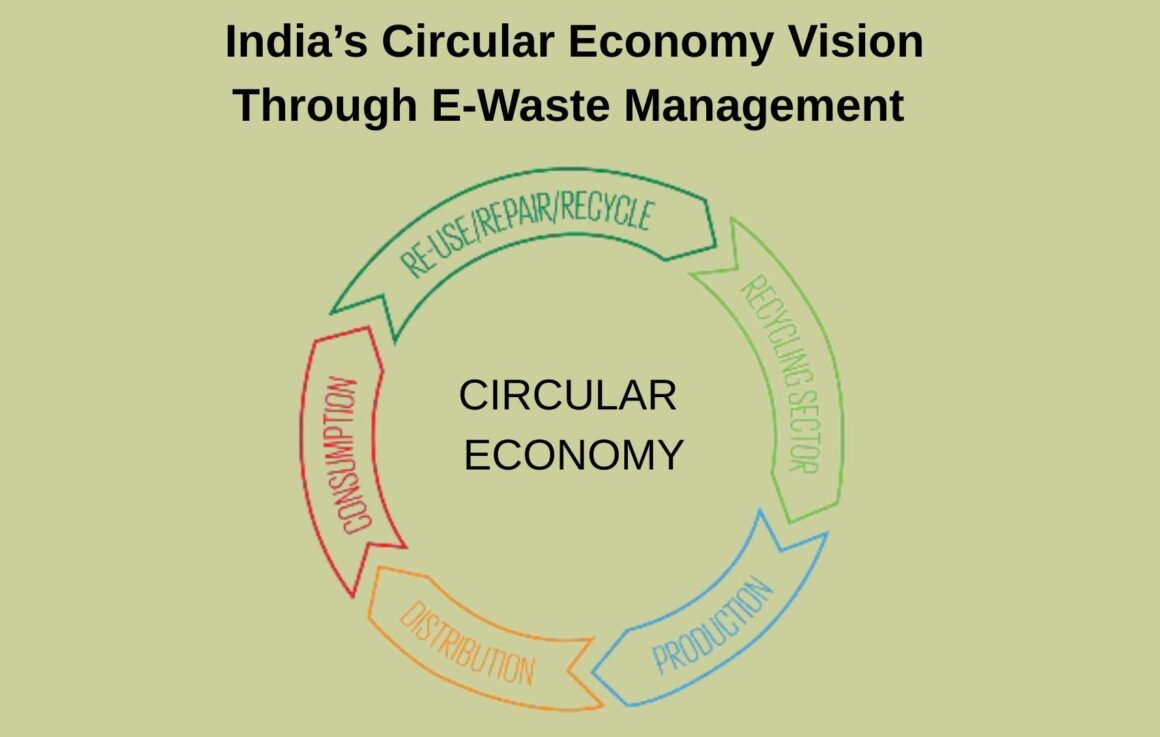“Turning Waste into Wealth: How India’s Circular Economy Vision Through E-Waste Management Policy is Powering a Circular Revolution.”
Understanding India’s Circular Economy Vision Through E-Waste Management
India’s Circular Economy Vision Through E-Waste Management refers to the nation’s strategic shift from a traditional “linearity” of production and consumption—where resources are used and discarded—towards a regenerative, sustainable model. In this model, electronic products are designed, used, collected, and recycled in a way that keeps materials in use for as long as possible. It emphasises resource efficiency, reduced waste generation, responsible disposal, and recovery of valuable materials from e-waste.
The vision aligns with India’s larger goals of sustainable growth, green employment, and reduced environmental degradation, turning waste into a resource and pollution into profit.

India’s Circular Economy Vision Through E-Waste Management: From Burden to Opportunity
India’s digital revolution has transformed lives, but it has also created one of the fastest-growing waste streams in the world: electronic waste. With millions of devices discarded each year—from smartphones and laptops to home appliances—the nation faces a mounting environmental crisis. Yet, within this challenge lies a powerful opportunity to fuel a circular economy, where waste becomes wealth.
India’s Circular Economy Vision Through E-Waste Management model promotes reducing, reusing, refurbishing, and recycling resources to extend their lifecycle. For India, e-waste management represents both a critical environmental imperative and a major economic opportunity. Recovering valuable materials like gold, copper, and rare earth elements could not only cut resource dependence but also create sustainable livelihoods.
Policy Evolution: The Framework of Change
India’s Circular Economy Vision Through E-Waste Management reflects its growing focus on circularity. The E-Waste (Management) Rules, 2016, laid the groundwork by introducing Extended Producer Responsibility (EPR) — making manufacturers accountable for the lifecycle of their products. Later amendments in 2018, 2022, and 2024 have expanded responsibilities, tightened enforcement, and aligned the sector with the circular economy vision.
Under the E-Waste (Management) Rules, 2022, producers must register on the CPCB EPR portal, collect e-waste in proportion to their market output, and ensure its recycling through authorised recyclers. The government explicitly states that these rules are designed to “promote circular economy through the EPR regime and scientific recycling.”
Producers can also trade EPR certificates, introducing market flexibility into compliance. Over time, recycling targets are expected to rise to 80% by 2028, reinforcing India’s commitment to sustainable growth.
Local Bodies, Audits & Accountability
Municipal corporations and panchayats now share responsibility for e-waste segregation and channelization. They must identify informal waste handlers, train local stakeholders, and build infrastructure for formal collection. To ensure transparency, environmental compensation, audits, and traceability have been introduced to penalize non-compliance and encourage responsible practices.
This decentralization marks a crucial shift—moving e-waste management from a policy objective to a grassroots practice.
The Informal Sector: Integrating the Backbone
India’s informal waste handlers have long been the invisible backbone of the recycling ecosystem. However, their unsafe practices—acid leaching, open burning, and unprotected dismantling—pose severe environmental and health risks. The new policy landscape aims to formalize these workers through training, incentives, and integration with registered recyclers.
Pilot projects under the UNFCCC’s Momentum for Change initiative and digital platforms like Recykal demonstrate how informal collectors can be empowered, digitized, and linked to authorized treatment facilities.
Innovations Powering the Circular Shift
India’s cities are witnessing the rise of eco-friendly innovation. Delhi is establishing its first E-Waste Eco Park at Holambi Kalan—a centralized facility designed for safe dismantling, recycling, and resource recovery. Meanwhile, startups and academic institutions are developing technologies such as AI-driven waste sorting, IoT-enabled traceability, and blockchain-based EPR verification.
Digital tools are bridging gaps between consumers, recyclers, and regulators—turning compliance into opportunity.
Challenges on the Road to Circularity
Despite policy ambition, implementation gaps persist:
- Informality & Fragmentation: Nearly 90% of India’s e-waste still passes through informal channels.
- Low Consumer Awareness: Most citizens remain unaware of drop-off points or recycling benefits.
- High Compliance Costs: Producers face financial and logistical challenges in meeting EPR targets.
- Technological Limitations: Few facilities possess advanced dismantling technologies for complex devices.
- Weak Enforcement: Transparency, audit accuracy, and inter-agency coordination remain inconsistent.
These bottlenecks highlight the need for investment, collaboration, and public education.
The Economic & Environmental Payoff
Transitioning to a circular model could deliver immense value:
- Resource Efficiency: Recovering metals and rare earths can reduce import dependence.
- Green Jobs: Formal recycling can generate employment in logistics, repair, and innovation sectors.
- Environmental Gains: Reduced landfill pressure and pollution from toxic e-waste components.
- Industrial Competitiveness: Boosting India’s position in global sustainable manufacturing chains.
Analysts estimate that effective circular economy practices could unlock US$ 1 trillion in economic value globally by 2030—with India poised to be a major contributor if it scales its e-waste framework effectively.
The Road Ahead: Policy, Partnership & Public Participation
For India to realize its circular vision, a multi-pronged strategy is essential:
- Eco-Design & Product Lifespan: Encourage modular and repairable electronics.
- Robust Collection Systems: Increase drop-off points, incentivize returns, and digitize tracking.
- Formalization: Empower informal workers with training, certification, and inclusion.
- Technology Upgradation: Invest in high-efficiency, clean recycling technologies.
- Data Transparency: Leverage digital dashboards to track compliance and outcomes.
- Consumer Awareness: Nationwide campaigns to promote responsible disposal.
Circularity is not merely about recycling—it’s about rethinking production, consumption, and waste itself.
India’s Circular Economy Vision Through E-Waste Management
India’s Circular Economy Vision Through E-Waste Management Policy Evolution represents a defining step toward a circular economy. By merging environmental responsibility with economic opportunity, the nation can transform its waste crisis into a sustainable growth story. The success of this vision depends on shared responsibility—from policymakers and corporations to consumers and recyclers.
If executed well, India can emerge not just as a global recycling hub, but as a pioneer in turning electronic waste into an ecosystem of renewal, resilience, and responsibility.
FOR MORE BLOGS – beyondthepunchlines.com

 Add to favorites
Add to favorites







